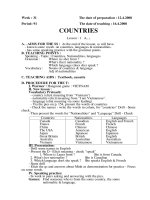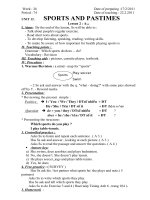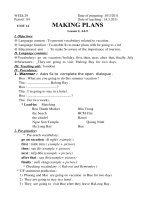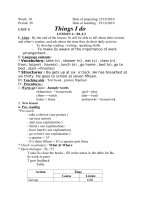Tiet 102,103,103,105-L11
Bạn đang xem bản rút gọn của tài liệu. Xem và tải ngay bản đầy đủ của tài liệu tại đây (133.09 KB, 7 trang )
Date of preparation: Date of signing:
Distributive period: 101 Date of teaching:
Unit 16
the wonders of the world
Lesson 4
Language focus
A. Aims and Objectives: By the end of the lesson, students will be able to:
- Distinguish the difference between the consonant clusters: / ft/, / vd /, / fs /, / vz/.
- Know how to use: It is said that.....and People say that.
B. Materials and Teaching Aids: Textbook, pictures, colored chalks.
C. Procedures:
Stages/Time Activities
Interactions
1. Warm-up
5 minutes
2.
Presentation
1
10 minutes
Presentation
2
14 minutes
* Homework
- Ask Ss to read their report.
- Listen and give comments and mark.
- T leads Ss to the lesson.
* Pronunciation:
- Hang on a flipchart of the sounds on the board and introduce the
sounds to the Ss. Teacher reads the sounds three times.
/ ft/ / vd/, /fs/ / vz/
gift
lift
soft
arrived
loved
moved
coughs
laughs
roofs
behaves
loves
knives
* Repetition:
- Ask Ss to read the words aloud.
- Ask Ss to add some more words that contain the sounds.
* Practice reading aloud the sentences.
- Practice reading aloud the sentences.
- Ask some Ss to read the aloud the sentences.
- Correct their mistakes if necessary.
* GRAMMA:
1. It is said/ believed that...and People say that...
- Teacher gives examples:
It is said that time is money.
People say that time is money.
- T remarks: Cả hai cùng có nghĩa là: Ngời ta nói rằng.
+ It is said/ believed that: Dùng cho dạng bị động của câu với túc
từ là một mệnh đề.
- T focuses the form:
S1 + V1 (that) + S2 + V2 + 0 + M
It + be + V1 (V-edP2) (that) S2 + V2 + 0 + M
S2 + be + V1 (V-edP2) + V2 (infinitive) + 0 + M
- T asks Ss to give some examples and rewrite the sentences using the
above structures.
- Teacher gives examples:
It is said that health is more precious than gold.
Health is said to be more precious than gold.
T <--> Ss
Ss <--> Ss
T <--> Ss
T <--> Ss
S<--> S
1
3. Practice:
14 minutes
5.Homework
2 minutes
a. Mệnh đề chính và mệnh đề túc từ cùng thời gian (cùng thì): V2 đợc ở
dạng nguyên mẫu đơn.
People believe (that) knowledge is the key to open all things.
Knowledge is believed to be the key to open all things.
b. Mệnh đề túc từ diễn tả hành động xảy ra trớc hành động của mệnh
đề chính V2 đợc ở dạng nguyên mẫu hoàn thành.
They know that the prisoner escaped from the jail.
The prisoner is believed to have escaped from the jail.
c. Mệnh đề chính và mệnh đề túc từ cùng thời gian nhng khác thì: V2 đ-
ợc ở thì tiếp diễn và V1 ở thì đơn.
They think that the police are searching for the murderer.
The police are thought to be searching for the murderer.
* Exercise 1: - Ask Ss to work in pairs to do Exercise 1.
- Give enough time for Ss to do it.
- Move around to help if necessary.
* Feedback: - Call on some Ss to read the sentences aloud.
+ Key: 1. Many people are said to be homeless after the floods.
2. The prisoner is thought to have escaped by climbing over the wall.
3. He is believed to have driven through the town at 90 km an hour.
4. Two people are reported to have been seriously injured in the
accident.
5. Three men are said to have been arrested after the explosion.
6. The strike is expected to begin tomorrow.
7. He is said to speak English well.
* Exercise 2: - Ask Ss to do exercise 2 in pairs.
- Move around to help if necessary.
- Ask Ss to compare their answers together.
* Feedback: - Call on some Ss to read their answers aloud.
+ Key: 1. He is thought to be very clever.
2. The wanted man is believed to be living in New York.
3. He is known to be very rich.
4. The film is supposed to be very good.
5. Many people are thought to have been killed in the accident.
6, About a million puppies are thought to be born each year.
7. The factories are said to be worse.
8. Those dogs are said to be dangerous.
- Prepare for the next part.
- Make two sentences using It is said that.....and People say that.
* Choose the best answer:
1. It was in this village that Mr. John................17 years ago.
A. were born B. was born C. born D. has been born
2. Nam is said ..................a big company in Ho Chi Minh city now.
A. be B. to have been C. been D. has been
3. His wife is said...............for her husband ten years before she
remarried.
A. be running B. to have run C. run D. will be running
4. The woman was said .................in the rain for 10 minutes.
A. wait B. to have waited C. waiting D. waited
T <--> S
Ss <--> Ss
S
Ss <--> Ss
Ss <--> Ss
D. To instruct Ss how to do the homework:
2
Date of preparation: Date of signing:
Distributive period: 102 Date of teaching:
the final revision ( 1
st
period)
A. Aims and Objectives: By the end of the lesson, students will be able to:
- Distinguish the clusters: /sp/, /st/, /sk/, /sm/, /sn/, /sw/.
- Revise the following grammar parts:
+ Relative clauses.
B. Materials and Teaching Aids: Textbook, pictures, colored chalks.
C. Procedures:
Stages/Time Activities
Interactions
8 minutes
14 minutes
17 minutes
I. Pronunciation:
- Help Ss read the words containing the following clusters: /fl/, /fr/,
/r /, /sp/, /st/, /sk/, /sm/, /sn/, /sw/.
- Ask Ss to add some more words that contain the sounds.
- Ask some Ss to read the aloud their words.
- Correct their mistakes if necessary.
II. GRAMMA:
1. Defining relative clauses.
- Mệnh đề quan hệ xác định là thành phần của câu, không thể bỏ
mệnh đề quan hệ xác định. Nó có thể đứng giữa hoặc cuối câu,
không ngăn cách với các thành phần khác của câu.
- Teacher gives examples:
Mary, who teaches English, comes from England.
2. Non-defining relative clauses.
- Mệnh đề quan hệ không xác định dùng trong câu với vai trò bổ
xung thông tin. Nếu bỏ mệnh đề quan hệ không xác định câu vẫn có
nghĩa. Nó có thể đứng giữa hoặc cuối câu, đợc ngăn cách với các
thành phần khác của câu bởi một dấu phẩy.
- Teacher gives examples:
This is the girl who teaches English.
3. Relative pronouns with prepositions
* Note: - A relative pronoun can be the object of a preposition.
- In formal English we can put the preposition before whom or which.
We cannot leave out whom or which here, and we cannot use who or
that.
- In informal English the preposition can come after verb or the object
of the verb. We can leave out the relative pronoun. ( Whom is formal
and rather old-fashioned. In everyday speech we often use who.)
a. Formal:
- The man to whom Tom is talking is his teacher.
- Ill introduce you to the man with whom I share a flat.
- This is the magazine about which I talked yesterday.
b. Informal:
- The man whom/ who/ that Tom is talking is his teacher (to).
-Ill introduce you to the man whom/ who/ that I share a flat(with)
- This is the magazine which / that I talked yesterday (about).
+ T elicits the use of relative pronouns with prepositions from Ss.
T <--> Ss
Ss <--> Ss
T <--> Ss
T <--> Ss
T <--> Ss
3
18 minutes
2 minutes
4. Relative clauses
+ Relative clauses replaced by participles and to infinitives.
1. Active participles.
- The man who spoke to John is my brother.
The man speaking to John is my brother
- Write some other examples on the board.
+ Note: We can use a present participle to replace a relative clause
which has active meaning.
2. Passive participles.
- The picture which was drawn by a blind has won the first prize.
The picture drawn by a blind has won the first prize.
- Elicit the rules from Ss.
- Write the notes on the board:
+ Note: We can use a past participle to replace a relative clause which
has passive meaning.
3. Infinitive relative clauses:
+ Note: - We can use to- infinitive to replace a relative clause.
- We often use a to- infinitive after an ordinal number ( first, second...)
after next and last, after, only and after superlative adjectives.
III. Homework
- As Ss to give examples for the above grammar parts.
T <--> Ss
Ss <--> Ss
D. To instruct Ss how to do the homework:
………………………………………………………………………………………………………...…
………………………………………………………………………………………………………...…
………………………………………………………………………………………………………...…
………………………………………………………………………………………………………...…
Date of preparation: Date of signing:
Distributive period: 104 Date of teaching:
the final revision ( 2
nd
period)
A. Aims and Objectives: By the end of the lesson, students will be able to:
- Distinguish the clusters: /str/, /skr/, /skw/, /pt/, /bd/, /ps/, /bz/, /ts/, /dz/, /tst/,/djd/.
- Revise the following grammar parts:
+ Relative clauses.
+ Cleft sentences.
B. Materials and Teaching Aids: Textbook, pictures, colored chalks.
C. Procedures:
Stages/Time Activities
Interactions
10
minutes
13 minutes
I. Pronunciation:
- Help Ss read the words containing the following clusters: /str/, /skr/,
/skw/, /pt/, /bd/, /ps/, /bz/, /ts/, /dz/, /tst/,/djd/.
- Ask Ss to add some more words that contain the sounds.
- Ask some Ss to read the aloud their words.
- Correct their mistakes if necessary.
II. GRAMMA
1. Omission of relative pronouns.
T <--> Ss
Ss <--> Ss
4
20 minutes
2 minutes
- Khi ®¹i tõ quan hÖ lµm tóc tõ ë mÖnh ®Ò quan hÖ x¸c ®Þnh chung ta cã
thÓ bá.
- Teacher gives examples:
The book which/ that I’m reading is one of Dickens’.
The book I’m reading is one of Dickens’.
2. Cleft sentences
+ Subject, object and adverbial focus
- Teacher gives example:
Tom gave a rose to Mary.
Tom gave a rose to Mary.
I saw a dog in the garden.
- T explains:
+ Tom in the above sentence is the subject of the sentence. To
emphasize subject, we can begin the sentence with:
It was (Subject) who.............
+ The rose in the above sentence is the object of the sentence. To
emphasize object, we can begin the sentence with:
It was (Object) that.............
+ In the garden in the above sentence is the adverbial of the sentence.
To emphasize adverbial, we can begin the sentence with:
It was (adverbial) that.............
For example: It was Tom who gave a rose to Mary.
It was the rose that Tom gave Mary.
It was in the garden that I saw a dog.
- T asks Ss to give some examples and rewrite the sentences using the
above structures.
III. Homework
- As Ss to give examples for the above grammar parts.
T <--> Ss
T <--> Ss
T <--> Ss
Ss <--> Ss
D. To instruct Ss how to do the homework:
………………………………………………………………………………………………………...…
………………………………………………………………………………………………………...…
………………………………………………………………………………………………………...…
………………………………………………………………………………………………………...…
Date of preparation: Date of signing:
Distributive period: 105 Date of teaching:
the final revision ( 3
rd
period)
A. Aims and Objectives: By the end of the lesson, students will be able to:
- Distinguish the clusters: /nt/, /nd/, /n0/, /ns/, /nz/, /ft/, /vd/, /fs/, /vz/.
- Revise the following grammar parts:
+ Conjunctions.
+ Tag questions.
+ It is said that ./ People say that… ……
B. Materials and Teaching Aids: Textbook, pictures, colored chalks.
C. Procedures:
Stages/Time Activities
Interactions
10
I. Pronunciation:
5









